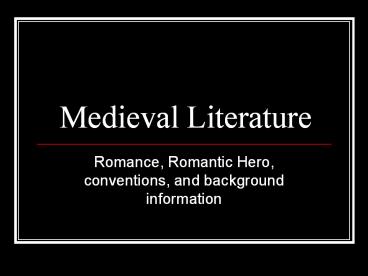Medieval Literature PowerPoint PPT Presentation
Title: Medieval Literature
1
Medieval Literature
- Romance, Romantic Hero, conventions, and
background information
2
Medieval Romance
- A tale of High Adventure. Can be a religious
crusade, a conquest for the knight's leige lord,
or the rescue of a captive lady or any
combination.
3
Medieval Romance
- The word romance comes from the Old French term
"romans," which was used to differentiate the
language of the people from the language of the
Church.
4
Medieval Romance
- The Church wrote and spoke Latin, a language
little changed from classical times. The lay
population spoke French, which was continuously
evolving from Celtic and Germanic influence
"romans" was the term for this language.
5
Medieval Romance
- These literatures were loosely-based historical
accounts from the beginning the authors who used
the vernacular realized that they must please as
well as edify, that history would not be
acceptable to their patrons unless made
entertaining.
6
Medieval Romance
- Legends, folk-lore, superstitions, etc. were
added to the mix to please the audience, and
historical truth became almost entirely lost. Any
declarations of "historical truth" were simply
for convention.
7
Medieval Romance
- Romance flourished in France from 1150-1250
those composed at later dates were usually
re-imaginings of the first efforts.
8
Romantic Hero
- Birth of a great hero is shrouded in mystery
9
Romantic Hero
- He is reared away from his true home in ignorance
of his real parents.
10
Romantic Hero
- For a time his true identity is unknown
11
Romantic Hero
- After meeting an extraordinary challenge, he
claims his right
12
Romantic Hero
- His triumph benefits his nation or group
13
Characteristics
- Medieval romance usually idealizes chivalry
- Chivalrous conduct, arising from the feudal
system and Christian morals, were a strong force
within romances. - Such conduct included loyalty to duty, courtesy,
and service to the oppressed. Loyalty was
paramount in a hierarchical social system,
courtesy and service to the oppressed was the
ideal in a religious system focused on humility
and godliness.
14
Characteristics
- Medieval romance Idealizes the hero and his noble
deeds
15
Characteristics
- An important element of the medieval romance is
the knight's love for his lady - The love element, while not necessary for a
romance (adventure alone can be considered
romantic), is nearly always present in medieval
versions, and of a particular kind. What we now
consider courtly love began in the middle of the
twelfth century, when a "woman-worship" arose,
stemming from the worship of the Virgin Mary.
What the "courtly" designation did to love was
elevate it to an art form. No longer was love
merely an emotion. Women were supreme, and the
essence of love was not passion or regard but
devotion. Love could not be exaggerated, since it
was the lover's role to satisfy every whim of his
lady. Fidelity and service were the ultimate
goals of love.
16
Characteristics
- The settings of medieval romance tend to be
imaginary and vague
17
Characteristics
- Medieval romance derives mystery and suspense
from supernatural elements - Although romance took on an unrealistic focus it
still followed certain conventions drawn from
real life. Christian morals find their way into
most romances, even though often intermingled
with pagan belief systems.
18
Characteristics
- Medieval romance uses concealed or disguised
identity
19
Characteristics
- Repetition of the mystical number "3."
(Repetitions of the number or multiples of 3)
20
Chevrefoil
- Marie de France (12th Century)
- Drew inspiration from Celtic tales
- Perhaps because she was female (we believe) she
tended to focus on the personal lives of both the
male and the female characters.
21
Nibelungenlied
- Considered the national epic of Germany
22
Chanson de Roland (Song of Roland)
- National epic of France
- An example of a chansons de geste or songs of
deeds (an epic poem relating the heroic deeds of
Charlemagne)
23
The Grail
- Chrétien de Troyes
- Part of the Arthurian Legend

